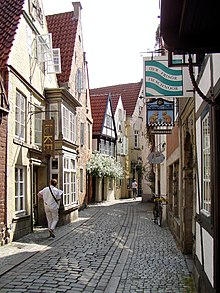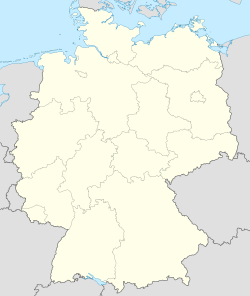| Bremen Bremen | ||
 | ||
Coat of arms and flag | ||
| State | Germany | |
|---|---|---|
| Federated state | Bremen | |
| Altitude | 11.5 m a.s.l. | |
| Surface | 326.73 km² | |
| Inhabitants | 548.547 (2013 census) | |
| Prefix tel | 49 421 | |
| POSTAL CODE | 28001–28779 | |
| Time zone | UTC 1 | |
Position
| ||
| Tourism site | ||
| Institutional website | ||
Bremen, in GermanBremen, is the capital of the homonymous state federated of the Germany.
To know
Bremen is an ancient and prosperous northern German city with a high standard of living and a happy life. City of the "Bremen Town Musicians", a World Heritage Site and the second German port since the Middle Ages, Bremen is one of those cities that must be visited at least once in a lifetime.
Geographical notes
Entirely surrounded by the federated state of the Lower Saxony, beautiful Bremen forms a federated state of its own together with the small city of Bremerhaven (literally "Port of Bremen") located about 60 km away and overlooking the North Sea.
Background
| (Old Low German) «Vryheit do ik ju openbar | (IT) «I communicate freedom to you |
| (Inscription on the shield of Roland of Bremen) | |
Already the Alexandrian geographer Ptolemy in 150 AD. he spoke of a city called "Fabiranum", identifiable with modern Bremen. At the time Bremen was home to the Germanic tribe of the Cauci, allies of the Romans since 12 AD. they had been defeated by the troops of the Roman general Drusus. At the time of Ptolemy, however, the city already presented itself as a stable settlement; it is difficult to say in what period Bremen was really founded.
It is certain that during the reign of Charlemagne this whole region underwent a forced Christianization. Following this process in 787 Bremen became an important religious center with its own bishopric led by Willehad, the first bishop of Bremen. Since 848 the bishop of Bremen-Hamburg he was responsible for the Catholic missions of the whole of northern Germany e Scandinavia.

Around the year 1000 Bremen also flourished under the commercial aspect; the routes to the Netherlands, Norway and England are opened and the city has its first walls. The importance of Bremen as a commercial center grew so rapidly that as early as 1260 it was fully accepted in the great Hanseatic League, a league of commercial cities, above all but not only German, that enjoyed particular privileges, a statute of their own and helped and protected each other militarily. each other.
Bremen's importance and independence are well symbolized by the statue of Roland, which stands majestically in the central square. The statue depicting the Orlando (Roland for the Germans) of the famous medieval Chanson de Roland was installed in 1404 and is not only a symbol of the city but also a UNESCO World Heritage Site.
Another sad proof of Bremen's importance among German cities is of more recent origin: as if it were a sequel to the terrible bombing of Cologne, in August 1942, the British threw 890,000 bombs on Bremen which destroyed almost 85%. of the city and caused the deaths of more than 3500 people.The monuments of Bremen have been reconstructed with tenacity and pride by its inhabitants according to the original design and arouse the admiration of visitors.
How to orient yourself
To settle in Bremen is not difficult at all; Like any ancient city, Bremen town planning revolves around the historic center with its very famous one 1 Marketplatz. Here you will already find much of what Bremen offers to tourists: the cathedral, the town hall, the statue of Roland and the sculpture of musicians. 2 Bremen central station you just need to walk for 10 minutes the road that crosses the ancient moat (Stadtgraben) (or take tram 22) to find yourself in the middle of the central square. As soon as you turn the corner of the cathedral begins Ostertorstrasse and together with it the district of Viertel. After the inevitable McDonald's, the road leads to Piazza Goethe where the theater and the Museum of Fine Arts are located (Kunsthalle Bremen).
Neighborhoods
The city-state of Bremen is made up of 22 official districts to which are added the suburbs and the port, often calculated as the 23rd district. Except for the center which is a real treasure for the visitor and concentrates the vast majority of attractions for the visitor, the other districts reflect, similar to each other, a rather recent evolution of the city. This is true for everyone except the neighborhoods north of the historic center. These in fact, due to their geographical position projected towards the North Sea, show their own and unmistakable character.

How to get
By plane

- 4 Bremen International Airport (Bremer Flughafen). south of the city, at a distance of 3.5 km from the center. Ryanair direct flights from Italy also operate here (Bergamo-Orio al Serio) as well as from major European cities. The line 6 tram takes you to the center in less than 15 minutes.
How to get around
The central areas can be explored on foot. For longer-range journeys it will be necessary to use public transport or even a bicycle. A rental point is at the central station. The roads are not uphill and their bottom is smooth. Especially the embankments of the riverside are suitable for cycling routes.
What see



- 1 Oltremare Museum (Überseemuseum), 13, Bahnhofsplatz D (Adjacent to the train station), ☎ 49 0421 160 38101. Permanent ethnographic exhibitions on extra-European cultures
- Town Hall Building (Bremer Rathaus).
 Visiting hours. Weekdays from 10:00 to 12:00. Considered to be one of the finest examples of Baltic-Gothic architecture, Bremen Town Hall was inscribed on the list UNESCO World Heritage Site in 2004. It was built between 1405 and 1410. In 1608 decorative elements in the Renaissance style were added to the facade by the intervention of Lüder von Bentheim, a local architect. The windows above the portico are interspersed with statues representing Charlemagne and the electors of the Holy Roman Empire.
Visiting hours. Weekdays from 10:00 to 12:00. Considered to be one of the finest examples of Baltic-Gothic architecture, Bremen Town Hall was inscribed on the list UNESCO World Heritage Site in 2004. It was built between 1405 and 1410. In 1608 decorative elements in the Renaissance style were added to the facade by the intervention of Lüder von Bentheim, a local architect. The windows above the portico are interspersed with statues representing Charlemagne and the electors of the Holy Roman Empire. - Church of Our Lady (Liebfrauenkirche) (North-west of the town hall). It stands on the site of an older church dedicated to San Vito of which it incorporates some parts. It was in fact enlarged in the 12th century and restored in the 13th century. One of the two towers that flanks it was used as an archive of the municipal council. It suffered severe damage during World War II. The restoration work was carried out between 1958 and 1965 under the direction of the architect Dieter Oesterlen. The stained glass windows are the work of the French artist Alfred Manessier
- Duomo (Bremer Dom), Sandstraße 10-12 28195 Bremen, Germany. Dedicated to St. Peter, the cathedral of Bremen was erected in 1043 in sandstone on the site of a pre-existing wooden church of which nothing remains. Over the centuries it underwent repeated interventions, the last of which dates back to 1950. During the bombings of World War II, the vaults of the church were completely destroyed. The cathedral museum houses frescoes and medieval tombs.
- Paula Modersohn-Becker Museum (Paula Modersohn-Becker Museum), Böttcherstraße. Museum dedicated to the painter Paula Modersohn-Becker born in Dresden in 1876. Closed for restoration (year 2012)
- Roselius House Museum (Museum im Roselius-Haus), Böttcherstraße.
- Church of San Giovanni (St.-Johannis-Kirche) (Schnoor area).
- Franciscan Convent (Schnoor area).
- House of the Sailors (Schifferhaus), Stavendamm 15, 28195 Bremen (Schnoor area).
- Museum of Ancient Art (Antikenmuseum), Schnoor area.
- Fine Arts Museum (Kunsthalle Bremen), 207, Am Wall 28195 Bremen, ☎ 49 421 329 080.
Events and parties
- Jazzahead! (In the Bremen Congress Center).
 In April. The event is accompanied by concerts held by the most beautiful names in jazz music but also by exhibitions and seminars.
In April. The event is accompanied by concerts held by the most beautiful names in jazz music but also by exhibitions and seminars. - Bremen Freimarkt. Popular festival that occurs on October 16 and lasts for a fortnight. The event is accompanied by parades, dances in the streets and involves the consumption of rivers of beers. It is far older than Oktoberfest's Monk dating back to 1035. The festival takes place in the park by the river and in the Bürgerweide near the train station.
What to do
Shopping
How to have fun
To find out what is trendy in Bremen consult the site on line of the Prinz magazine but it is only in German.
Shows
Concerts, dance performances, theater and opera performances are held at the Theater in Piazza Goethe (Theater am Goetheplatz) headquarters of Bremen theater.
Night clubs

Below is a list of dance clubs in vogue in 2008:
- Aladin-Music-Hall, Hannoversche Straße 11 (6 km east of the center.), ☎ 49 421 435 150.
- Modernes, 28, Neustadtswall - 28199 Bremen (Steinwegtor district, on the left bank of the river), ☎ 49 421 505553. Theme nights in this venue housed in an old movie theater
- StuBu Club, Rembertiring 1-25 - 28195 Bremen (In the station area at the intersection with Hochstrasse). We drink beer and dance until the wee hours on the wave of the latest commercial successes. StuBu is the busiest nightclub in Bremen.
- [link not working]Sinatra's Dancing, Rembertiring 18 (Close to the Stubu club). A place frequented by an audience that is no longer young and nostalgic for the motifs of the past
- Tower Musikclub, Herdentorsteinweg 7 - 28195 Bremen (Railway station area), ☎ 49 421 323 334. For heavy metal lovers
Among the gay clubs, the Rat & Tat Zentrum für Schwule und Lesben. It is located at No. 1 of Theodor-Körner-Straße (Southwest of Goetheplatz).
Gambling games
Bremen owns a casino located at number 3 of the famous Böttcherstraße. To access it, you need to show a document.
Where to eat
The central stretch of the riverfront known as "Schlachte"is, par excellence, an area of breweries and restaurants. You will find the most varied, including Italian ones.
Böttcherstrasse instead it is the street of restaurants specialized in fish dishes.
The Viertel district has numerous restaurants frequented by students and therefore with moderate prices.
Moderate prices
- Restaurant Luv - Café. Bar. Lounge, Schlachte 15 • 28195 Bremen, Germany. Among the cheapest and most renowned of the restaurants lined up on the riverside. You can enjoy "Wiener Schnitzel", breaded veal slices fried in butter
Where stay
Moderate prices
- Backpacker Hostel, Emil-waldmann-strasse 5-6. 28205 Östliche Vorstadt, Bremen (Close to the train station), ☎ 49 421 223 8057.
- Pension Weidmann, Am Schwarzen Meer 35, ☎ 49 421 498 4455.
Average prices
- Schlafcompany, Ölmühlenstr. 1-3 (Close to the train station), ☎ 49 421 2767921.
- Gästezimmer-Vermietung, Calvinstraße 38 28217 Walle (2.5 km from the railway station). Pension. Rooms with shared bathroom.




